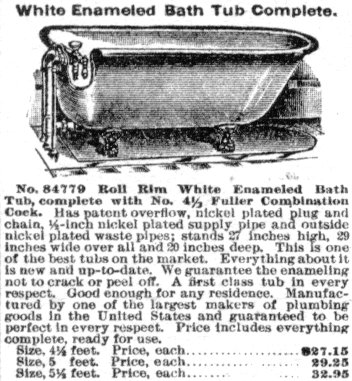Cleaning Ourselves
Today, let's bathe. The University of Houston's College of Engineering presents this series about the machines that make our civilization run, and the people whose ingenuity created them.
I opened my 1897 Encyclopaedia Britannica to see what's listed under the word bath or bathing, and neither word appeared. But under the word baths is an eight-page, double-column, fine-print entry dealing with the way we clean ourselves. It treats Roman baths in detail -- showing layouts, plumbing, and accessories. The Romans didn't fool around when it came to keeping clean.
Then the article goes into modern systems of public bathing -- says they're pretty similar to the old Roman baths. It talks about vapor baths and hot springs. The section on The Action of Baths on the Human System is an eye-opener. It's filled with warnings about bathing in water too hot or too cold. Does water seep in through the skin? What does bathing do to the psyche?
This long article yields only one sentence about domestic bathing. It says, "Cold and hot baths have been introduced into [English] homes to an extent never known before." So, scarcely a hundred years ago, domestic bathing was still a novelty.
"Coeducational" public bathhouses were widespread in medieval Europe. Then, in the late thirteenth century, conservative voices closed them down. The resulting drop in personal cleanliness left populations vulnerable to the Bubonic Plague. European personal hygiene standards stayed low for a long time. It was common to go a year between baths in our old West.
Private bathrooms equipped with a tub or a shower were creatures of the new late-nineteenth-century consumerism. They evolved while trial versions were being sold. First were shower devices. A typical one consisted of a treadle that you worked with your feet to pump water into a handheld spray nozzle.
The game changed with the development of public water-supply systems. In 1885 George Vanderbilt had one of the first in-house bathtubs supplied with running water. Fifteen years later, my 1900 Sears Roebuck catalog offers ten different bathtubs. Prices range from $3.50 for a four-foot tin tub to thirty dollars for a white-enameled iron tub with water faucets. No more mention of showers.
I was raised in a large house, built in 1898. It was typical of middle-class living in America until after WW-II. It had one bathroom upstairs, a washbasin in a downstairs coatroom, and an isolated toilet under the basement stairs. The upstairs bathroom had an iron tub and no shower.
In those days a tub faucet might've been fitted with a hose and a spray attachment. But full private shower stalls (outside the tub or built into it) have come into use only during my adult life. My 1897 Britannica recommends that bathing for hygienic purposes be done before 1:00 PM and on an empty stomach. That suits me. It's out of bed and into the shower before coffee, before thought, before deciding what program to write today. I find it implausible that I once lived in a world where that was unheard-of luxury.
I'm John Lienhard, at the University of Houston, where we're interested in the way inventive minds work.
(Theme music)
Gimpel, J., The Medieval Machine. New York: Penguin Books, 1976.
Weaver, R., and Rodney, D., Machines in the Home. Oxford: Oxford University Press, 1992.
Consumer Guide. Sears, Roebuck, and Co., Chicago: 1900.

From the 1905 Sears and Roebuck Catalog